October 3, 2005
We drove from Trelleborg on the south coast of Skåne across the 'new' bridge from south of Malmö to south of Copenhagen and found our hotel without too much difficulty in a nice little street off 'Rådhuspladsen'.
After lunch in a pleasant little basement restaurant across the street from our hotel, we set out on a long walk through our favorite places in the Danish capital. First of all, our beloved 'Gammel strand', the street where the legendary 'Krogs Fiskerestaurant' still is today after probably 100 years on the same premises, Gammel Strand 38. Price level : High says the guide books. We've been there a couple of times so we had decided not to go back on this visit.
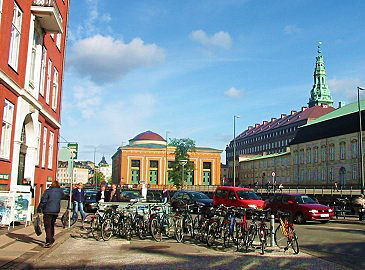 |
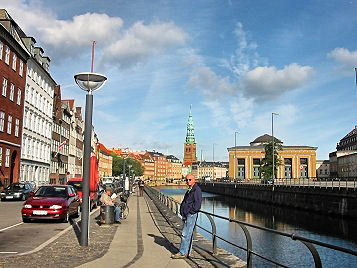 |
| A first view of
Thorvaldsens Museum in the center just before we turn into Gammel
Strand on the left. This wonderful museum opened in
1848, Copenhagen's very first museum, dedicated to the enormously
prolific and widely appreciated sculptor and painter, Bertel
Thorvaldsen
(1770 - 1844). On the right in the photo, you can see the tower of Christiansborg
Slot (Castle), on Slotsholmen, the home of the Danish Parliament
(folketinget) behind what is presumably adminsitrative buildings. And, of course, the ubiquitous bicycles, the trade mark of Copenhagen. |
John at the beginning of Gammel Strand with the old and picturesque buildings on the left. On the right is Thorvaldsens Museum on Slotsholmen. |
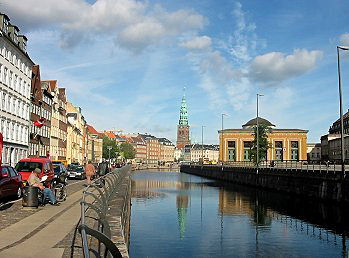 |
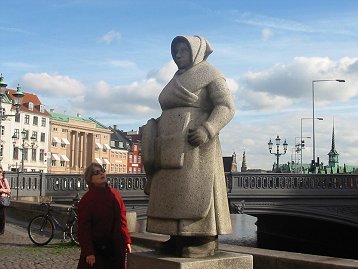 |
| We are walking down Gammel Strand towards the place that used to be the open air market for fresh fish. Krogs fiskerestaurant is on the left, most likely where one of the flags is hanging out from the front wall. In the background, we think, is the church that was transformed into a museum. | Here is Siv next to the famous statue of the fish mongeress, at the end of Gammel Strand. The men fished during the night and the women sold the fish in the early morning, until very recently on this very quay and on the small square behind me, Fisketorvet. Over on the right is the pointed tower of the Danish Stock Exchange (Börsen). |
 |
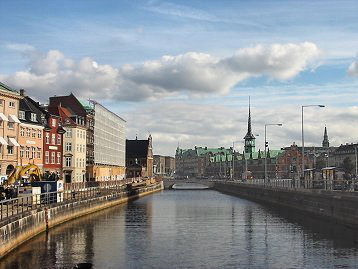 |
| Fisketorvet seen from the statue of the fish mongeress. The equestrian statue is presumably one of the Danish kings named Christian, but uncertain which one. This used to be the open air fish market but has now turned into a sidewalk café. | We are looking down southeast towards the Stock Exchange (Börsen) - the green roofs and the pointed tower on the right |
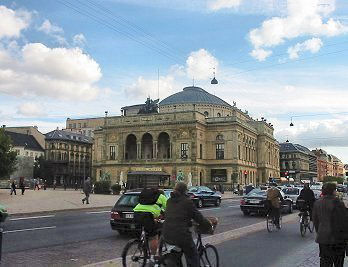 |
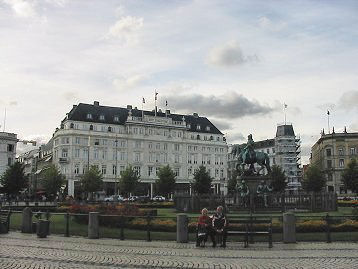 |
| We wound our way up north to Kongens Nytorv (The King's New Plaza) and the Kongelige Teater. Statues of Ludvig Holberg and Adam Oehlenschläger guard the entrance to this imposing old theater. It dates from 1748 and was from the beginning the theater of the king. It later became the theater of the whole country. |
Hotel d'Angleterre seen
across Kongens Nytorv with the equestrian statue of Christian V in the
middle of the park. The Plaza was named after this king. (The King's New Plaza) |
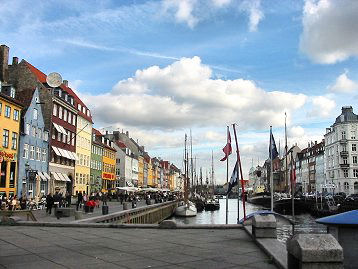 |
Just around the corner from Kongens Nytorv is the famous Nyhavn (New harbor), which used to be, in my early youth, a place where Swedish dupes got robbed of their money in smoky and ill reputed dance places. The warehouses that were lining the canal in those days have since been fixed up to be less shady and have become a different kind of tourist traps with sidewalk cafés and always a huge crowd of tourists, from Japanese to Americans. |
| On our way back to the hotel, we passed closer to Börsen (the Stock Exchange) with its serpentine tower. Here we are on Börsgade on our way north-west, where we are going to walk around the back and the side of Thorvaldsens Museum on Slotsholmen. | 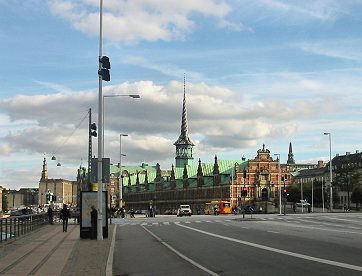 |
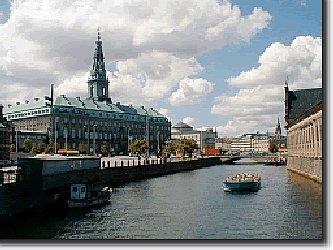 "Christiansborg
Castle is surrounded by a 2 km long canal with 8 bridges crossing over it." "Christiansborg
Castle is surrounded by a 2 km long canal with 8 bridges crossing over it." (An Internet photo, since for some strange reason I didn't think of taking a photo of the castle. We were walking right by it - on the island of Slotsholmen.) |
Christiansborg
Castle "Christiansborg Castle houses the Danish Parliament and is the third castle constructed since the very first castle was built 800 years ago and on the very same spot where Bishop Absalon built the first castle. Today's Christiansborg Castle was built in stages during 1907-28, and beside being the seat of the Danish Parliament (Folketing) the castle also houses the Royal Reception Rooms with the Great Hall used for banquets held for foreign heads of state and diplomatic audiences." |
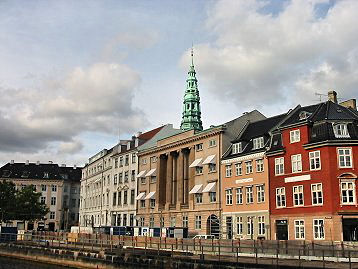 |
We are on our way back to Gammel Strand, only on the castle side of the canals surrounding the Slotsholmen. |
| A quaint and colorful little street with a few of the obligatory bicycles. On our way back to our point of departure along Börsgaden and in front of Christiansborg Castle, we had to fight all the bicycles to cross the street on Vindebrogade across the canal from Gammel Strand and Nybrogade. When a hoard of bicycles are threatening their onslaught, you do well to stand aside. | 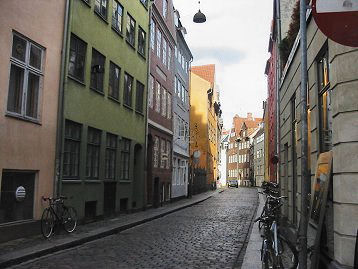 |
The New Carlsberg Glyptotek (picture)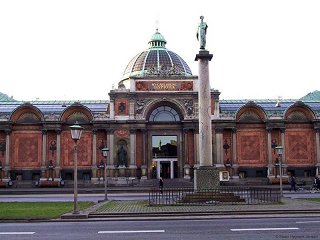 |
"The Ny Carlsberg
Glyptotek was founded by the brewer Carl Jacobsen
(1842-1914) who created one of the largest private
art collections of his time. It was named after his
brewery, Ny Carlsberg, with the addition of
"Glyptotek", meaning collection of sculpture." ... "Today, the museum houses the largest collection of ancient art in Northern Europe, primarily sculpture, from Egypt, the Near East, Greece and Italy. But during the more than one hundred years of its existence, the museum has also expanded the collection of French and Danish art from the nineteenth and twentieth centuries. The Impressionists, Paul Gauguin and Auguste Rodin are particularly well represented." |
| Rådhuspladsen (the City Hall Square) and the old and very chic Palace Hotel on the left. The very center of Copenhagen from Tivoli and the Grand Central Station (Hovedbangården), across Rådhuspladsen down to Kongens Nytorv and Nyhavn is easily covered in one afternoon, even with small side trips and stops for looking around and reminiscing. However, if you want to go over east to Amalienborg, the Royal Palace, and where the major embassies are also located, you would preferably need another day. |
 |
My much beloved Tivoli Gardens, the oldest amusement park in Europe
and probably the most fascinating one in the western world.
We walked by the Tivoli entrance in the evening, only to find that they were closed for the season. I had never seen it closed before and it was of course a disappointment. Of course they are only open in the summer though, and also for a much shorter Christmas season.
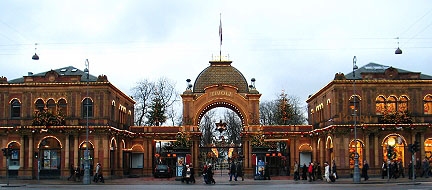 "Tivoli opened in summer 1843 under the name of "Tivoli & Vauxhall," borrowing on the names of London's and Paris' great pleasure gardens of the time. It was founded by Georg Carstensen, a military man and avid traveller, who picked up the idea during his journeys through Europe and applied with King Christian VIII to run a similar place in Copenhagen. Carstensen received a five-year charter and permission to use an area of land just outside the city's fortifications. |
He designed Tivoli according to the English tradition, with natural-looking landscapes, which were beautifully illuminated at night. For modern visitors, time seems to have stood still at Tivoli. The partly Oriental-style buildings, theaters and cafés set into the beautifully landscaped gardens blend well with the modern equipment such as rides, thus preserving the romantic, almost magical atmosphere of times long gone-by. The effect is particularly outstanding after dusk, when all the artificial lights go on." There are also numerous stages where world famous performers come to entertain, acrobats, singers and prestidigitators, which you can watch without paying an additional fee. They are perhaps even more remarkable than the rides. Also, there used to be an extraordinary flee circus, but alas, it's gone. |
| The entrance to the Tivoli Gardens. Typically relaxed Copenhageners on a warm summer day. This was the paradise of my childhood and youth and I still love it with a vengeance. My first visit to the park was soon after my family had moved to Malmö, right across from Copenhagen, from a bit farther up north. There is a picture in a family album (which I don't have here) of me and cousin Kerstin on a children's ride when we were both 5 or 6 years old. It was just before the outbreak of the war and for 6 years after that Copenhagen was of course 'terra non grata' for us Swedes during the German occupation. |
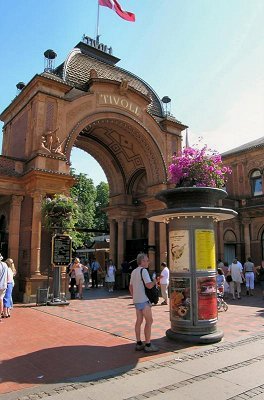 |
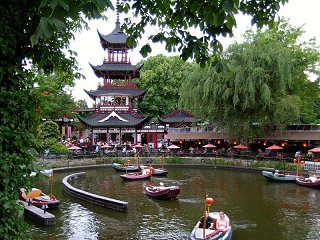 |
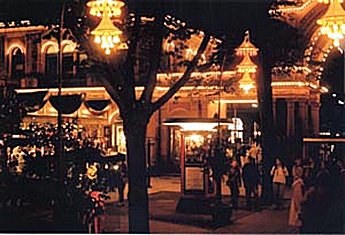 |
| The Chinese Pagoda with "The Chinese Tower" Restaurant behind the pond with the paddle boats. |
Tivoli Gardens is a famous amusement park in Copenhagen, Denmark. The park opened on August 15, 1843 and, except for Dyrehavsbakken in nearby Klampenborg, it is the oldest amusement park which has survived intact to the present day. |
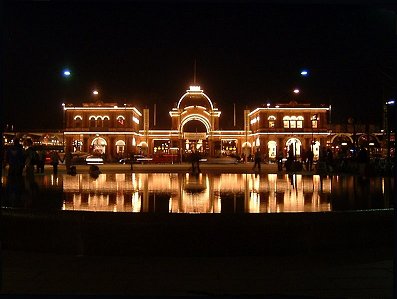 |
| The entrance to the Tivoli Gardens seen from the interior. The whole park is sheer magic. |